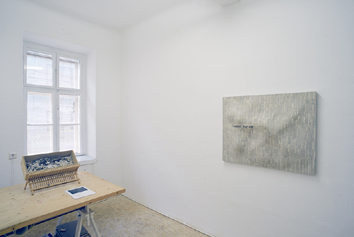01
16.06. 2018
__________________________________
toni kleinlercher : FAZ, 22.04.15
private viewing 01 , Installationsansicht, Atelier Toni Keinlercher, Foto © Günther Selichar
Toni Kleinlercher, FAZ, 22.04.15
Foto © Günther Selichar
Günther Selichar, AFRAID?
Foto © Günther Selichar
vasja nagy-hofbauer zu private viewing 01
till dusk – Who needs information?
When you live in constant fear (Roger Waters)
The two artworks of Günther Selichar and Toni Kleinlercher contraposing at this exhibition are coming from different grounds in aspect of form and content. Selichar’s flat image is constructed with rectagular net of cells of three basic colours, used in electronic devices for colour image reproduction: red, green and blue. In his case this sequence starts with blue and ends with green which is a reference to the painting of Barnett Newman Who’s afraid of red, yellow and blue. The Newman sequence relates to the basic colours of painting, while Selichar’s colours come from creating images with light. There is a word game especially intriguing in German language because the first letters of colours don’t change: rot, gelb und blau – rot, grün und blau. Günther Selichar shifts the beginning on to the blue and causes some kind of surprise, or uncertainty at the first glance. This is simply the same sequence present in everyday life on the displays of smartphones, computers and TV-sets, but usually the user is not aware of it, which makes this structure invisible. And making visible the invisible is certainly the most characteristic feature in Selichar’s artworks while his attention is particularly focused on modern media.
On the other hand, Kleinlercher work is constructed with an old medium, a printed text as the opposition to the representation of the light based images in this exhibition. In fact it is the whole copy of a daily newspaper used for it. Sheets are cut in to columns and picked up by chance to cover the surface. The rest of material builds up the relief. One can still read parts of the news but the fragmentary nature of the text does not allow the reconstruction of the original story, it encourages to assemble a new one instead. The image keeps the appearance of a newspaper page while acquiring the character of an abstract landscape. It seems like the information is not important and the poetic of the text fragments placed casually or perhaps according to the visual effect, or both combined.
I’ve heard of people and read about them, but mostly I saw them on the TV or in movies, who like to read a newspaper first thing in the morning. Some drink coffee, others tea, few of them eat eggs and toast in the meantime. I never really met anyone who does this routine, but I notice many in the subway or tram, who read those papers offered “priceless” in the streets or browse similarly precious content in their smartphones. Somehow it is all about the information when it comes to media and more the technology moves away from the physical presence of the carrier of meaning, more hypnotic the means are.
The artworks of Selichar and Kleinlercher are both exposing the materiality, the crucial condition for the existence of signs and language and meanings. Somehow both cases deconstruct the medium itself. Kleinlercher mutilates the newspaper beyond its use but giving it a new life and widens its meanings. While Selichar shows in the form of a photograph, what usually stays outside of conscious, a close-up of the display where white and grey decompn tose io the three colours mentioned above. The writing is visible only from a distance and causes unsettling feelings asking about being afraid. While the newspaper is readable from the vicinity and it brings comfort.
Günther Selichar, AFRAID?
Foto © Günther Selichar
Toni Kleinlercher, FAZ, 22.04.15
Foto © Günther Selichar
© 2018 Toni Kleinlercher




